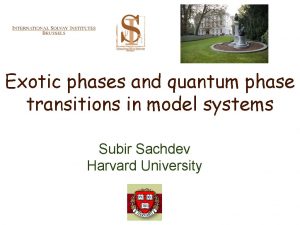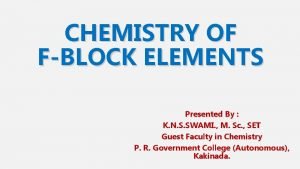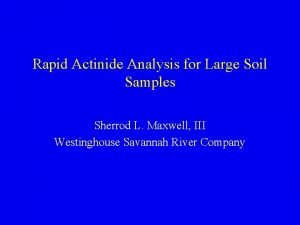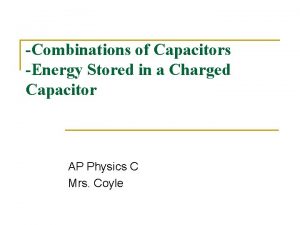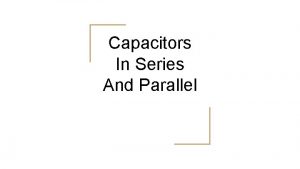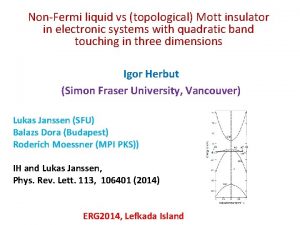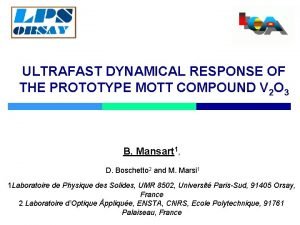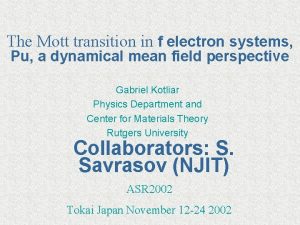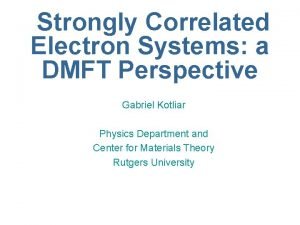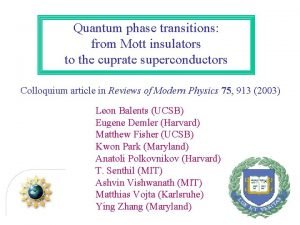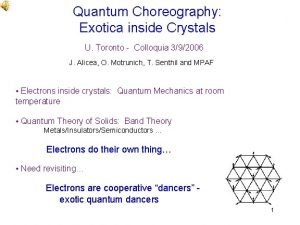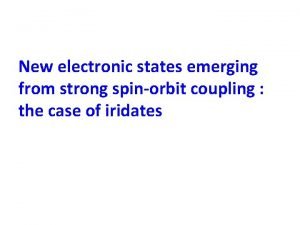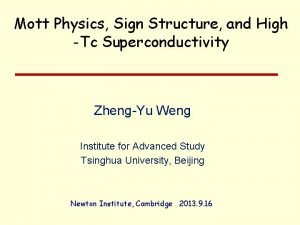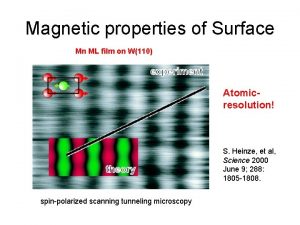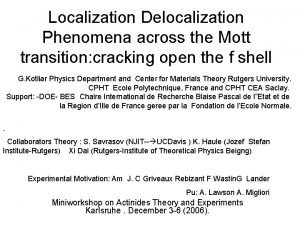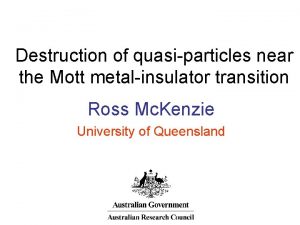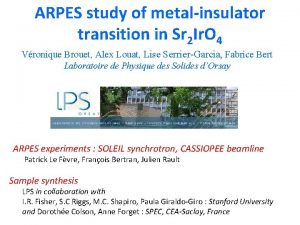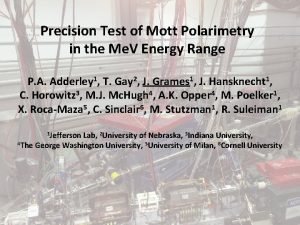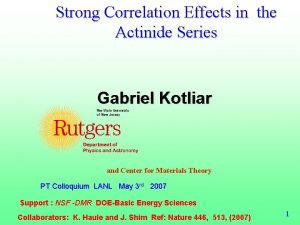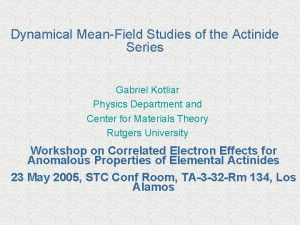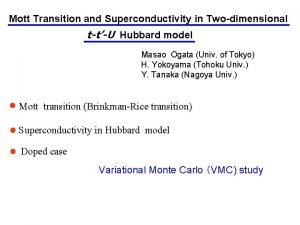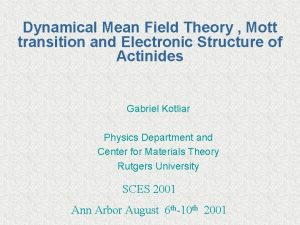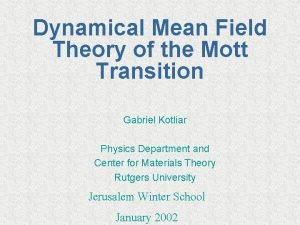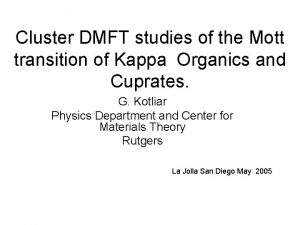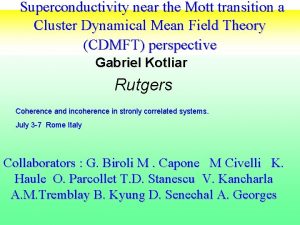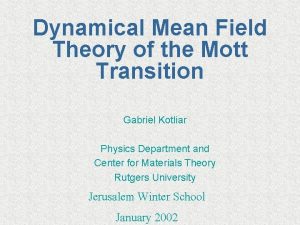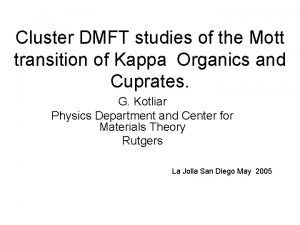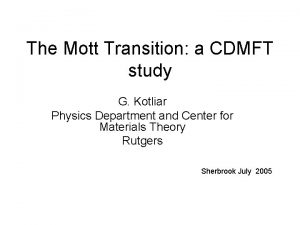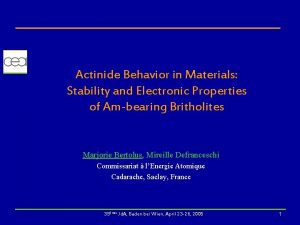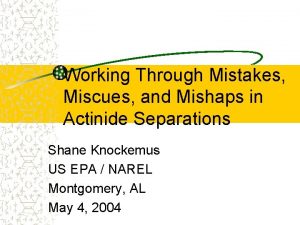The Mott transition across the actinide series and
























![2/3<l. s> in the late actinides [DMFT results: K. Haule and J. Shim ] 2/3<l. s> in the late actinides [DMFT results: K. Haule and J. Shim ]](https://slidetodoc.com/presentation_image/3b7023a272ea5b8e4f5c2cbfb551e6e4/image-25.jpg)

![Photoemission Spectra[ Shim. Haule, GK Nature (2007)] alpa->delta volume collapse transition F 0=4. 5, Photoemission Spectra[ Shim. Haule, GK Nature (2007)] alpa->delta volume collapse transition F 0=4. 5,](https://slidetodoc.com/presentation_image/3b7023a272ea5b8e4f5c2cbfb551e6e4/image-27.jpg)











![Conclusion Am • Americium undergoes Mott transition under pressure. [Am. III-Am. IV] boundary. • Conclusion Am • Americium undergoes Mott transition under pressure. [Am. III-Am. IV] boundary. •](https://slidetodoc.com/presentation_image/3b7023a272ea5b8e4f5c2cbfb551e6e4/image-39.jpg)





























- Slides: 68

The Mott transition across the actinide series and the double life of delta Plutonium. Gabriel Kotliar and Center for Materials Theory Colloquium : City College NY April 11 (2007) $upport : NSF -DMR DOE-Basic Energy Sciences Collaborators: K. Haule and J. Shim Ref: Nature 446, 513, (2007) 1

OUTLINE • The challenge of strongly correlated electron systems. • Late actinides: experimental overview • Introduction to Dynamical Mean Field Theory (DMFT). • Theory of delta Pu • Theory of Am and Cm • Conclusions

Electrons in a Solid: the Standard Model Band Theory: electrons as waves. Landau Fermi Liquid Theory. bands , optical transitions , Rigid thermodynamics, transport……… • Quantitative Tools. Density Functional Theory • Kohn Sham (1964) Static Mean Field Theory. Kohn Sham Eigenvalues and Eigensates: Excellent starting point for 2 perturbation theory in the screened interactions (Hedin 1965)

Spectral Function Photoemission and correlations e • Probability of removing an electron and transfering energy w=Ei-Ef, and momentum k f(w) A(w, K) M 2 n a) Weak Correlation b) Strong Correlation n Angle integrated spectral function 8

Strong Correlation Problem: where the standard model fails • • • Fermi Liquid Theory works but parameters can’t be computed in perturbation theory. Fermi Liquid Theory does NOT work. Need new concepts to replace of rigid bands ! Partially filled d and f shells. Competition between kinetic and Coulomb interactions. Breakdown of the wave picture. Need to incorporate a real space perspective (Mott). Non perturbative problem. 4

Strongly correlated systems • Copper Oxides. High Temperature Superconductivity. • Cobaltates Anomalous thermoelectricity. • • Manganites. Colossal magnetoresistance. Heavy Fermions. Huge quasiparticle masses. 2 d Electron gases. Metal to insulator transitions. Lanthanides, Transition Metal Oxides, Multiferroics………………. . 5

Superconductivity among 5 f elements Localisation 1. 4 K 0. 4 K s/c 0. 9 K Delocalization 0. 8 K 52 K 25 K AF 52 K FM

Localization Delocalization in Actinides Mott Transition a d Pu a d after G. Lander, Science (2003).

Basic Questions • How does the electron go from being localized to itinerant. • How do the physical properties evolve. • How to bridge between the microscopic information (atomic positions) and experimental measurements. • New concepts, new techniques

Phases of Pu (A. Lawson LANL)

Approach the Mott point from the right Am under pressure. Experimental Equation of State (after Heathman et. al, PRL 2000) “Soft” Mott Transition? “Hard”

Small amounts of Ga stabilize the d phase (A. Lawson LANL)

Anomalous Resistivity Maximum metallic resistivity

Specific heat and susceptibility. Pu is non magnetic

Standard model fails for the late actinides • Predicts all the phases of Pu and Am to be magnetic, with a large moment. (about 5 m. B) • Imposing paramagnetism, DFT fails to describe the volume of delta Pu by 25 % • Many modfications have been attempted, to explain why Pu is non magnetic. Mixed level model (Wills et. al. ) Pu has (5 f)4 conf. LDA+U amf (Shick, Anisimov) Pu has (5 f)5 • Cannot account for anomalous elastic properties, transport and thermodynamics

DMFT A. Georges and G. Kotliar PRB 45, 6479 (1992). Happy marriage of atomic and band physics. Extremize functional of A(w) Extremize a functional of the local spectra. Local self energy. Reviews: A. Georges G. Kotliar W. Krauth and M. Rozenberg RMP 68 , 13, 1996 Gabriel Kotliar and Dieter Vollhardt Physics Today 57, (2004). G. Kotliar S. Savrasov K. Haule V. Oudovenko O. Parcollet and C. Marianetti (RMP 2006).

Dynamical Mean Field Theory • Weiss field is a function. Multiple scales in strongly correlated materials. • Exact large coordination (Metzner and Vollhardt 89) , kinetic vs interaction energy • Immediate extension to real materials DFT+DMFT Functionals of density and spectra. • Review Kotliar et. al. RMP (2006) 12

. T/W Phase diagram of a Hubbard model with partial frustration at integer filling. [Rozenberg et. al. PRL 1995] Evolution of the Local Spectra as a function of U, and T. Mott transition driven by transfer of spectral weight Zhang Rozenberg Kotliar PRL (1993). .

Volume Collapse Transitions: relaxing the lattice positions. Savrasov et. al. 19

Phonon freq (THz) vs q in delta Pu X. Dai et. al. Science vol 300, 953, 2003

Inelastic X Ray. Phonon energy 10 mev, photon energy 10 Kev. E = Ei - Ef Q =ki - kf

DMFT Phonons in fcc d-Pu C 11 (GPa) C 44 (GPa) C 12 (GPa) C'(GPa) Theory 34. 56 33. 03 26. 81 3. 88 Experiment 36. 28 33. 59 26. 73 4. 78 ( Dai, Savrasov, Kotliar, Ledbetter, Migliori, Abrahams, Science, 9 May 2003) (experiments from Wong et. al, Science, 22 August 2003) 21

The “DMFTvalence” in the late actinides. 22 Time scale of the fluctuations. Ef*

W 110 =2/3<l. s> and banching ratio Moore and van der Laan, Ultramicroscopy 2007.
![23l s in the late actinides DMFT results K Haule and J Shim 2/3<l. s> in the late actinides [DMFT results: K. Haule and J. Shim ]](https://slidetodoc.com/presentation_image/3b7023a272ea5b8e4f5c2cbfb551e6e4/image-25.jpg)
2/3<l. s> in the late actinides [DMFT results: K. Haule and J. Shim ] See the expt. work of K. Moore G. Van der Laan G. Haire M. Wall and A. Schartz Am H 2

alpa->delta Photoemission Gouder Havela Lande PRB(2001)r
![Photoemission Spectra Shim Haule GK Nature 2007 alpadelta volume collapse transition F 04 5 Photoemission Spectra[ Shim. Haule, GK Nature (2007)] alpa->delta volume collapse transition F 0=4. 5,](https://slidetodoc.com/presentation_image/3b7023a272ea5b8e4f5c2cbfb551e6e4/image-27.jpg)
Photoemission Spectra[ Shim. Haule, GK Nature (2007)] alpa->delta volume collapse transition F 0=4. 5, F 2=7. 15 F 0=4, F 2=6. 1 20

Photoemission and Mixed valence in Pu

Conclusions • Unique properties of Pu and Am under pressure result from a proximity of a localization delocalization transition. Rare form of mixed valence. • DMFT provides a good start. Qualitative insights, some quantitative predictions into delta Pu. Other Pu phases. • Meaningful interplay of theory and experiment. Key in condensed matter physics.

Conclusions • Pu is a unique strongly correlated element. It is one among many strongly correlated electron system, materials for which neither the standard model of solids, works well. • They require, new concepts, new computational methods, new algorithms, DMFT provides all of the above, and is being used in many other problems. • Many applications to othe problems exist, others are in progress, research opportunity in correlated materials.


Approach the Mott point from the right Am under pressure. Experimental Equation of State (after Heathman et. al, PRL 2000) “Soft” Mott Transition? “Hard” Density functional based electronic structure calculations: q Non magnetic LDA/GGA predicts volume 50% off. q Magnetic GGA corrects most of error in volume but gives m~6 m. B (Soderlind et. al. , PRB 2000). q Experimentally, Am has non magnetic f 6 ground state with J=0 (7 F 0)

Am equation of state. LDA+DMFT. New acceleration technique for solving DMFT equations S. Savrasov K. Haule G. Kotliar cond-mat. 0507552 (2005)

Mott transition in open (right) and closed (left) shell systems. Superconductivity ? Localized (5 f)6 in L. S coupling or jj coupling ? S g. T Log[2 J+1] S Tc ? ? ? Uc U J=0 g ~1/(Uc-U) U


Photoemission spectra using Hubbard I solver and Sunca. [Savrasov Haule and Kotliar cond-mat 0507552 PRL (2006)] Hubbard bands width is determined by multiplet splittings.

Resistivity of Am under pressure. J. C. Griveau et. al. PRL 94, 097002 (2005).

Photomission Spectra of Am under pressure. Sunca. Onset of mixed valence. Savrasov Haule Kotliar (2005) PRL (2006)
![Conclusion Am Americium undergoes Mott transition under pressure Am IIIAm IV boundary Conclusion Am • Americium undergoes Mott transition under pressure. [Am. III-Am. IV] boundary. •](https://slidetodoc.com/presentation_image/3b7023a272ea5b8e4f5c2cbfb551e6e4/image-39.jpg)
Conclusion Am • Americium undergoes Mott transition under pressure. [Am. III-Am. IV] boundary. • Unusual superconductivity and resistivities. • Theoretical clue mixed valent due to admixture of (5 f) upon application of pressure. • Realizes Mott transition from the insulating side, towards a close shell configuration. .


. Mott transition in the open shell case. Heathman et. al. Science 309, 110 (2006) Approach the Mott transition from the right.

Curium is magnetic Hurray et. al. Physica. B (1980) 217 m=2 S+L LS coupling L=0 S=7 m=7 jj coupling J=7/2 m=3+1=4 Expt monent. is closer to L S coupling

K. Haule and J. Shim Trends in Actinides alpa->delta volume collapse transition F 0=4, F 2=6. 1 F 0=4. 5, F 2=7. 15 F 0=4. 5, F 2=8. 11 Curium has large magnetic moment and orders antif Pu does is non magnetic. Gouder Havela Lander

Conclusion • DMFT conceptual framework to think about electrons in solids. • Finite T Mott transition in 3 d. Single site DMFT worked well! • Ab-initio many body electronic structure of solids. Building theoretical spectroscopies. • Frontier, cuprates, lower T, two dimensionality is a plaquette in a medium enough? • Inhomogenous structure in correlated materials • New renormalizaton group methods built around DMFT ? 28

Conclusion • A Few References …… • A. Georges, G. K. , W. Krauth and M. J. Rozenberg, Reviews of. Modern Physics 68, 13 (1996). • G. K, S. Y. Savrasov, K. Haule, V. S. Oudovenko, O. Parcollet, C. A. Marianetti, RMP 78, 865 -951, (2006). • G. K and D. Vollhardt Physics Today, Vol 57, 53 (2004). 29

Conclusions • Constant interplay between theory and experiment has lead to new advances. • General anomalies of correlated electrons and anomalous system specific studies, need for a flexible approach. (DMFT). • New understanding of Pu. Methodology applicable to a large number of other problems, involving correlated electrions, thermoelectrics, batteries, optical devices, memories, high temperature superconductors, ……. .

Conclusions • DMFT produces non magnetic state, around a fluctuating (5 f)^5 configuraton with correct volume the qualitative features of the photoemission spectra, and a double minima structure in the E vs V curve. • Correlated view of the alpha and delta phases of Pu. Interplay of correlations and electron phonon interactions (delta-epsilon). • Calculations can be refined in many ways, electronic structure calculations for correlated electrons research program, MINDLAB, ….

What do we want from materials theory? • New concepts , qualitative ideas • Understanding, explanation of existent experiments, and predictions of new ones. • Quantitative capabilities with predictive power. Notoriously difficult to achieve in strongly correlated materials.

Some new insights into the funny properties of Pu • Physical anomalies, are the result of the unique position of Pu in the periodic table, where the f electrons are near a localization delocalization transition. We learned how to think about this unusual situation using spectral functions. • Delta and Alpha Pu are both strongly correlated, the DMFT mean field free energy has a double well structure, for the same value of U. One where the f electron is a bit more localized (delta) than in the other (alpha). Negative thermal expansion, multitude of

Quantitative calculations • Photoemission spectra, equilibrium volume, and vibration spectra of delta. Good agreement with experiments given the approximations made. Many systematic improvements are needed. • Work is at the early stages, only a few quantities in one phase have been considered. • Other phases? Metastability ? Effects of impurities? What else, do electrons at the edge of a localization do ? [ See epsilon Pu spectra ]

Collaborators, Acknowledgements References Collaborators: S. Savrasov ( Rutgers-NJIT) X. Dai ( Rutgers), E. Abrahams (Rutgers), A. Migliori (LANL), H Ledbeter(LANL). Acknowledgements: G Lander (ITU) J Thompson(LANL) Los Alamos Science, 26, (2000) S. Savrasov and G. Kotliar Phys. Rev. Lett. 84, 3670 -3673, Funding: NSF, DOE, LANL. (2000). S. Savrasov G. Kotliar and E. Abrahams, Nature 410, 793 (2001). X. Dai, S. Savrasov, G. Kotliar, A. Migliori, H. Ledbetter, E. Abrahams Science, Vol 300, 954 (2003).

Cluster DMFT: removes limitations of single site DMFT Cluster DMFT • No k dependence of the self energy. • No d-wave superconductivity. • No Peierls dimerization. • No (R)valence bonds. Reviews: Georges et. al. RMP(1996). Th. Maier et. al. Reviews: RMP (2005); Kotliar et. . al. RMP (2006). 23

Two Site Cellular DMFT ( Two Site Cellular DMFT G. . Kotliar et. al. PRL (2001)) in the 1 D Hubbard model M. Capone M. Civelli V. Kancharla C. Castellani and GK PRB 69, 195105 (2004)T. D Stanescu and GK PRB (2006) U/t=4. 24

Kohn Sham Eigenvalues and Eigensates: Excellent starting point for perturbation theory in the screened interactions (Hedin 1965) Self Energy Van. Shilfgaarde (2005) 3

Smith Kmeko Phase diagram. Minimum in melting curve and divergence of the compressibility at the Mott endpoint

The enhancement of the specific heat, further evidence for an open shell configuration, presence of electronic entropy. J. Lashley et. al. PRB(2005)

Double well structure and d Pu Qualitative explanation of negative thermal expansion[Lawson, A. C. , Roberts J. A. , Martinez, B. , and Richardson, J. W. , Jr. Phil. Mag. B, 82, 1837, (2002). G. Kotliar J. Low Temp. Physvol. 126, 1009 27. (2002)] F(T, V)=Fphonons+ Finvar Natural consequence of the conclusions on the model Hamiltonian level. We had two solutions at the same U, one metallic and one insulating. Relaxing the volume expands the insulator and contract the metal.

“Invar model “ for Pu-Ga. Lawson et. Mag. Vol. 86, Nos. 17– 18, 11– 21 June 2006, 2713– 2733 (2006) Data fits if the excited state has zero stiffness.

Dynamical Mean Field Theory. Cavity Construction. A. Georges and G. Kotliar PRB 45, 6479 (1992). A(w) 10

A(w) A. Georges, G. Kotliar (1992) 11

Expt. Wong et. al.

Elastic Deformations Uniform compression: Dp=-B Volume conserving DV/Vdeformations: F/A=c 44 Dx/L F/A=c’ Dx/L In most cubic materials the shear does not depend strongly on crystal orientation, fcc Al, c 44/c’=1. 2, in Pu C 44/C’ ~ 7 largest shear anisotropy of any element.


Localization Delocalization in Actinides Mott Transition d Pu a a d after G. Lander, Science (2003). Modern understanding of this phenomena using functional approach to. DMFT. K Haule S. Savrasov J Shim 18

<w 110> = n 7/2 – 4/3 n 5/2 nf = n 7/2 + n 5/2

Spectral Function and Photoemission e • Probability of removing an electron and transfering energy w=Ei-Ef, and momentum k f(w) A(w, K) M 2 n n Angle integrated spectral function 8

Kohn Sham Eigenvalues and Eigensates: Excellent starting point for perturbation theory in the screened interactions (Hedin 1965) Self Energy Succesful description of the total energy and the excitation spectra of a large number of simple metals semiconductors and insulators. Succesfully predicts semiconducting gaps, phonon frequencies, resistivities, of countless materials. a) Weak Correlation b) Strong Correlation 3

W 110 =2/3<l. s> and banching ratio See the expt. work of K. Moore G. Van der Laan G. Haire M. Wall and A. Schartz Am H 2
 Mott transition
Mott transition Lanthanides have poor tendency to form complexes
Lanthanides have poor tendency to form complexes Actinide
Actinide Actinide
Actinide What is the energy stored in the combination of capacitors
What is the energy stored in the combination of capacitors Parallel and series capacitor formula
Parallel and series capacitor formula Neural pruning ib psychology
Neural pruning ib psychology Curva de mott
Curva de mott Gurney mott theory of latent image formation
Gurney mott theory of latent image formation Kim mott
Kim mott Topological mott insulator
Topological mott insulator Mott
Mott Mott
Mott Mott
Mott Tableuu
Tableuu Mott
Mott Mott insulator
Mott insulator Mott insulator
Mott insulator In quoits, what is the hob, the mott, or the pin?
In quoits, what is the hob, the mott, or the pin? Mott
Mott Cameron mott
Cameron mott Mott
Mott Mott
Mott Mott
Mott Mott
Mott Mott insulator
Mott insulator Mott polarimeter
Mott polarimeter Serena mott
Serena mott Kerandel sign
Kerandel sign Series aiding and series opposing
Series aiding and series opposing Maclaurin series vs taylor series
Maclaurin series vs taylor series Balmer series lyman series
Balmer series lyman series Serie de taylor
Serie de taylor Maclaurin polynomial
Maclaurin polynomial Ibm p series models
Ibm p series models Series series feedback amplifier examples
Series series feedback amplifier examples Arithmetic sequence sum formula
Arithmetic sequence sum formula Hình ảnh bộ gõ cơ thể búng tay
Hình ảnh bộ gõ cơ thể búng tay Lp html
Lp html Bổ thể
Bổ thể Tỉ lệ cơ thể trẻ em
Tỉ lệ cơ thể trẻ em Gấu đi như thế nào
Gấu đi như thế nào Chụp phim tư thế worms-breton
Chụp phim tư thế worms-breton Chúa sống lại
Chúa sống lại Môn thể thao bắt đầu bằng chữ f
Môn thể thao bắt đầu bằng chữ f Thế nào là hệ số cao nhất
Thế nào là hệ số cao nhất Các châu lục và đại dương trên thế giới
Các châu lục và đại dương trên thế giới Công thức tính thế năng
Công thức tính thế năng Trời xanh đây là của chúng ta thể thơ
Trời xanh đây là của chúng ta thể thơ Mật thư anh em như thể tay chân
Mật thư anh em như thể tay chân 101012 bằng
101012 bằng độ dài liên kết
độ dài liên kết Các châu lục và đại dương trên thế giới
Các châu lục và đại dương trên thế giới Thơ thất ngôn tứ tuyệt đường luật
Thơ thất ngôn tứ tuyệt đường luật Quá trình desamine hóa có thể tạo ra
Quá trình desamine hóa có thể tạo ra Một số thể thơ truyền thống
Một số thể thơ truyền thống Cái miệng nó xinh thế
Cái miệng nó xinh thế Vẽ hình chiếu vuông góc của vật thể sau
Vẽ hình chiếu vuông góc của vật thể sau Nguyên nhân của sự mỏi cơ sinh 8
Nguyên nhân của sự mỏi cơ sinh 8 đặc điểm cơ thể của người tối cổ
đặc điểm cơ thể của người tối cổ Ví dụ về giọng cùng tên
Ví dụ về giọng cùng tên Vẽ hình chiếu đứng bằng cạnh của vật thể
Vẽ hình chiếu đứng bằng cạnh của vật thể Vẽ hình chiếu vuông góc của vật thể sau
Vẽ hình chiếu vuông góc của vật thể sau Thẻ vin
Thẻ vin đại từ thay thế
đại từ thay thế điện thế nghỉ
điện thế nghỉ Tư thế ngồi viết
Tư thế ngồi viết Diễn thế sinh thái là
Diễn thế sinh thái là Dot
Dot
